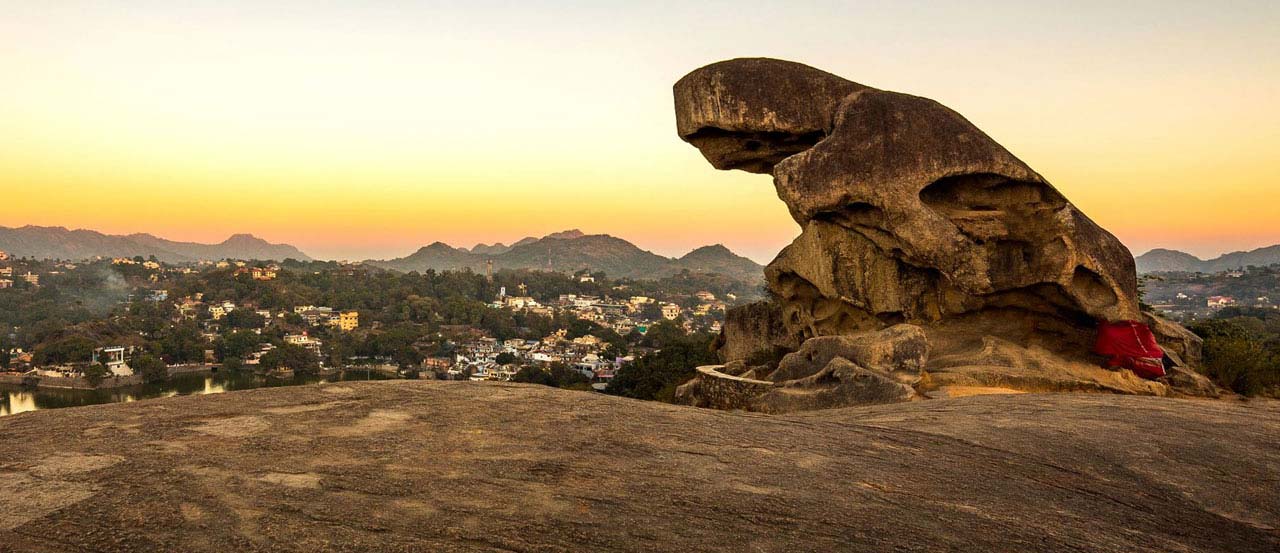 PLACES OF INTEREST ARE
PLACES OF INTEREST ARE
Gaumukh Temple: A natural spring flowing through a sculpted cow's head gives the shrine its name. The famous 'yagna' of sage Vashishtha was performed here. A beautifully sculpted hill temple of Arbuada - the mighty serpent stands against the beautiful backdrop. Nearby is the magnificent marble image of Nandi, the celestial bull rescued by Arbuada.
Nakki Lake: To pass and energetic evening rowing or simply to drift along, enjoying nature's beauty, be at the focal point of the town, Nakki Lake. This lovely artificial lake is ringed by hills and overhung by the enormous Tod Rock. Exploring the lake's little islets is a pleasant recreation. It is said to have been dug by the gods themselves with their nails, hence its name "Nakki". The summer villas of many Rajput rulers have been converted into hotels overlooking the lake.
Dilwara Jain Temples: Built between 11th and 13th century A.D, these temples are famous for their superb carvings in marble.
Adhar Devi Temple: Chiseled out of a huge rock, this temple is one of the favourite tourist spots of Mt. Abu. A climb of 360 stairs leads to the hill, on which this beautiful marble temple is situated. It it believed that he image of the goddess was originally hanging in mid-air, hence the name Adhar Devi.
Sunset Point: The best Mountain View can be savoured form Sunset Point, south west of Nakki Lake, where the sun gradually drowns itself in the azure sky between two mountain peaks. Steps lead up to a high terrace which offers an awe-inspiring view of the setting sun.
Honeymoon Point: A rather secluded spot, which looks beautiful at sunset hour. It also presents a pleasant view of the Abu Valley and the green fields on the other side of the mountains. Its older name was Anadra Point.
Shri Raghunathji Temple: Situated near the 'Nakki' lake is the temple dedicated to Shri Raghunathji with a beautiful image of the deity that was placed here in 14th century A.D. by Shri Ramanand the famous Hindu preacher.
Gardens & Parks: Beautifully laid parks and gardens are interspersed throughout the hilly paradise. Ashok Vatika, Gandhi Park, Municipal Park, Shaitan Singh Park and Terrace Garden are some of the noteworthy gardens.
MUSEUMS AND ART GALLERIES
Government Museum: The only hill station in western and central India Mount Abu has been a center of cultural activity since the pre-historic period. It was the capital of the Parmars in 13th century AD and later on came under the Chauhans. The museum was set up in 1962 within the premises of Raj Bhawan to preserve the archeological wealth of the region. The first section has been adorned by a diorama of local tribal hut with their usual living style by adding a gallery of weapons, musical instruments, ladies ornaments like barly, damani, karna, guthma toda, gaga walal thoomar, kanksi berla, various type of earrings and garments etc belonging to hill dwellers. The second section has a series of miniature paintings based on raga-ragnis, Jain images from Sirohi, medium sized shields, a small canon called "Topdi" and some pieces of the carvings on local wood. The notable collection of this museum is the finely carved out statues of Devdasi or Nartakis (Dancer) ranging from 6th - 1 2 century AD procured from an ancient township called Chandravati, 7 kms away from Abu. There is an image of Chakrabau Shiva having a Trishul in one hand and a Khadag in the other and sitting on Nandi, the bull. On each side of Shiva are dancing girls. In the Abu collection consisting of 404 sculptures, the most distinctive exhibit is the Vish Kanya (snack goddess) which is 3 feet high. The Sculpture Gallery has some memorial inscriptions collected from nearby areas e.g. Chapa's inscription (local heroine of Achalgarh).
EXCURSIONS
Trevor's Tank (5 km): A part of the forest around Mt. Abu has been turned into a wildlife sanctuary. The road runs through thickly wooded hills alive with peasants, peacocks and partridges. The hills open out to a clearing which contains a deep pool built by a British engineer, after whom the tank is named. A small forest lodge overlooks the pool. Trevor's Tank is a bird-watcher's paradise.
Achalgarh: A fort, just a little away from Abu, along a motorable road upto Uria. The ascent has to ber made on food through steeply rising woods. Only the ramparts and broken walls remain, of the original fort built by Rana Kumbha in the 14th century. Palanquins are available on hire for those not in a position to walk. Among the beautiful temples to be seen in the fort are Achaliswar Mahadev Temple or Lord Shiva Temple (1412 AD), and the Shantinath Jain Temple (1513 AD) which has gold-plated image.
Guru Shikhar: Guru Shikhar is the highest point on the mount & commands a birds eye-view of Abu and the surroundings areas. Temples located in this area are the Mira Temple, Chaumundi Temple & small Shaivite shrine on the "Shikhar".
FAIRS & FESTIVALS
Summer Festival: The Summer Festival is held every year in the month of Aashadh (June). The steep rocks, tranquil lakes, picturesque locations and the pleasant climate of Mount Abu make it an ideal location for the festival.
Post completion of your tour you will be driven back to Udaipur and be dropped at your hotel/residence.